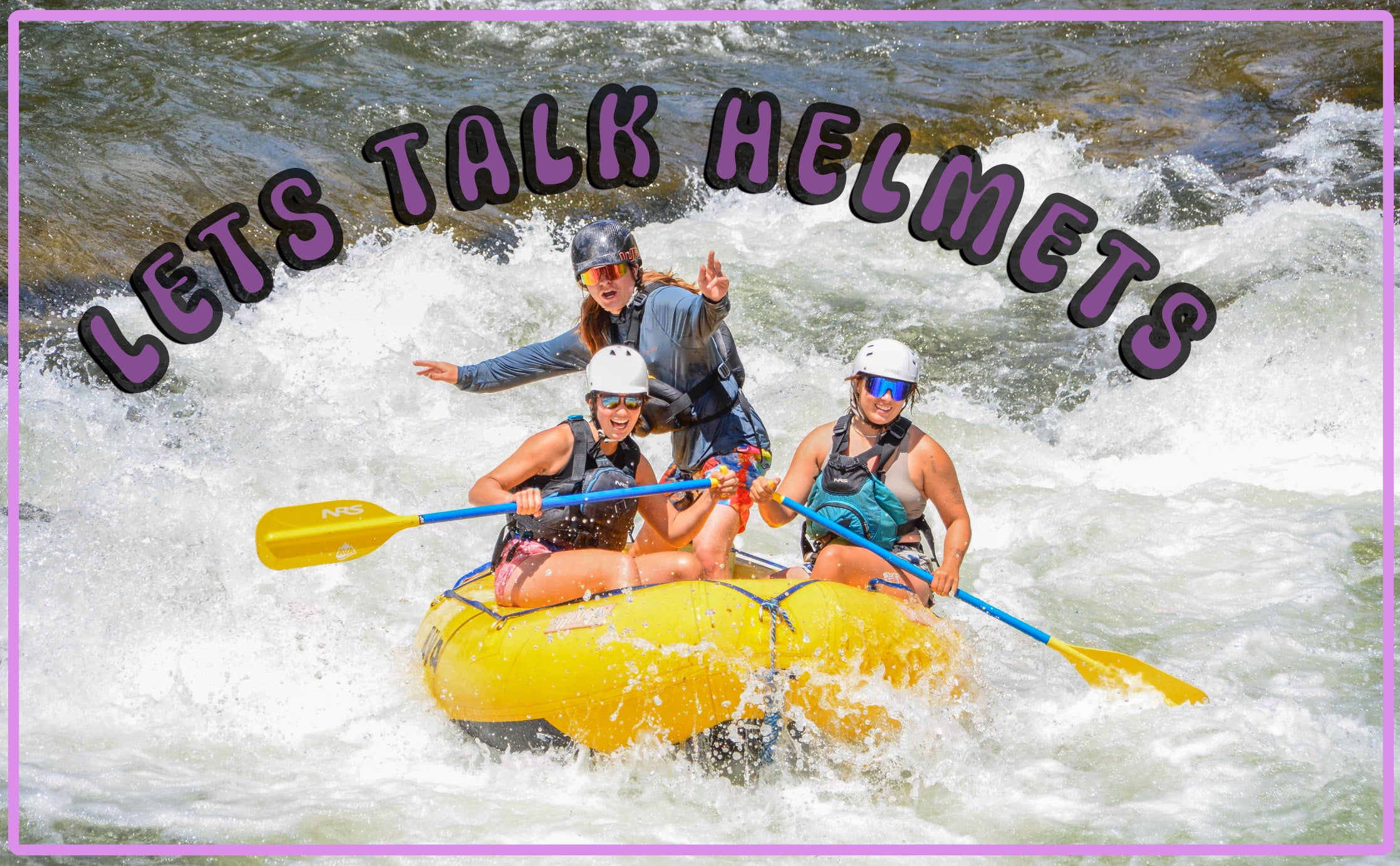There are so many different styles of whitewater helmets on the market. From brands to sizing–there are many different things to consider.
But, at the end of the day, the main reason you purchase a helmet is for safety. You only have one brain. No matter what your level within your whitewater sport is, finding a helmet that fits you well is a top priority. When trying on helmets, it is important that it fits snugly without any back and forth or side to side movement. When you go and try some helmets on, be sure it passes the rockstar test.

For starters, go with a whitewater specific helmet! This may seem like a no-brainer, but you’d be surprised how many bicycle or rock climbing helmets we see on the river. Helmets for other sports are great for other sports but they are not designed to endure the same impacts as whitewater sports. Another thing to consider is hand-me-downs. If you are thinking about buying a used helmet, it is important to consider the risk. Unless you know them personally, there is really no way of knowing what that helmet has been through in its past life. This is similar to buying a climbing rope without knowing how many falls it has taken. Would not recommend it!
Realistically, the best way to figure out what helmet is going to work for you is to try them on. So, go try on some friends' brain buckets or come on down to RSG. We have a stellar selection of helmets from NRS and Sweet Protection.
Let’s talk about the specs, pros, and cons to all of these helmets to help figure out what the BEST whitewater helmet would be for YOU.

Virginia Tech Study
There are different safety measurements that we can look at to decide what truly is the safest helmet. The best study to take a look at when picking out your whitewater helmet is the Virginia Tech Study. This study is based on what helmets are going to keep your risk of concussion down while paddling.
Virginia Tech took 31 whitewater helmets and rated them based on the helmet’s ability to “reduce linear and rotational acceleration of the head from a range of whitewater and paddle sport head impacts,” (Virginia Tech). They performed numerous tests on some of the most popular helmets on the market. This study can help you decide what helmet is going to be the safest while on the water if you are debating between a few different fits and styles that work for you.
Sweet Protection Helmets
We’ll be honest, it’s hard to ignore the signs that point you towards a Sweet Protection whitewater helmet. Not only does this brand occupy the entire Top 5 in the Virginia Tech study, but they are also endorsed by plenty of whitewater professionals and Red Bull athletes. For top of the line safety, Sweet Protection is THE helmet. So let’s talk about a few of the most popular options for this brand.
The Wanderer II
Sweet Protections’ Wanderer II is the most affordable option while still being incredibly safe, lightweight, and comfortable. Whether you are a private boater, raft guide, or a kayaker, this helmet provides maximum safety without sacrificing too much of the sleekness. It is THE best all around river specific helmet.
The Wanderer II goes over the ears and farther down on the back of the head than a lot of other helmets, which gives you better all around protection. Not only that, but the Wanderer II also gives boaters different padding options to better fit your head.
It might also be important to note that this helmet comes out #2 in the Virginia Tech study (#1 being its predecessor The Wanderer).
We rank this one #1 for the most versatile, all-around helmet for any type of boater.

The Rocker Helmet
Ranking #5 on the Virginia Tech study, comes The Rocker from Sweet Protection. This helmet is designed for high performance athletes. If you’re chasing big water, especially in a kayak or other type of small vessel, this helmet is going to keep you the safest in the industry.
The Rocker gives you comfort to charge hard with its carbon-fiber reinforcements and is designed to keep you safe in bigger water. Its design allows you to stay upside down for longer while keeping a snug fit on your head, despite rocks and hydraulics. Along with this, the visor on the Rocker provides some extra shade and face protection.
The only thing to consider is that this helmet may be a bit bulky for playboaters and raft guides. If you’re spending all day out of the water and in the sunshine, the extra padding may be a bit warm. But, the ear padding is removable for those hotter days.
We’ll rank this as our #1 pick for kayakers.
The Strutter Helmet
We’ll be the first to admit—The Strutter looks good. It’s a classic.
Designed in 1997, its baseball cap visor is a fan favorite and looks great on the river. If you’re leaning towards the Strutter, it continues to provide great protection despite its low-profile and sleek design. However, this one ranks a bit lower in regards to safety, coming in at #20 on the Virginia Tech study.
We will note, if you’re debating on getting this helmet as a kayaker, there have been some complaints about rolling with a bill that big, it tends to collect a lot more water than you’d like under the surface. With that, we highly recommend trying this helmet on. The sizing and fit seem to be a bit more inconsistent than other helmets and some head types don’t fit in this helmet well.
Despite this, it’s still a great option for play-boaters and raft guides alike. You’ll see this helmet up and down the river.
NRS/WRSI
Now, moving on to the NRS/WRSI helmets. WRSI stands for Whitewater Research and Safety Institute. This brand and organization was founded to advance whitewater safety awareness and technology. NRS sells the WRSI helmets, which makes them incredibly accessible as one of the biggest brands in the game. There are three of these that stand out.
The WRSI Current Helmet
This WRSI Current helmet is the most affordable option from WRSI. The construction of this helmet has a multi-impact shell as well as a very comfortable, breathable inner liner. Despite the lack of protection around the ears, it is a great option for a sleeker fitting helmet for raft guides and for people in warmer weather.
One thing to note, is that the adjustment on all of the WRSI helmets can be a little bit finicky, but once you get them adjusted you shouldn’t have to move it around too much. But, the ability to adjust the helmet is definitely a welcome one.
We do think that this helmet is one of the most comfortable helmets on the market, but it does seem to come at a cost. This helmet comes in at #25 out of 31 helmets on the Virginia Tech study and has a tendency to be a bit more wobbly on those bigger swims.

The WRSI Current Pro Helmet
An upgraded version of the WRSI Current, the WRSI Current Pro has some added safety features giving it a leg up in more challenging whitewater scenarios. The Current Pro comes with removable ear pads that provide warmth and can provide more protection during impacts. One of the other differences is the addition of a visor which allows for greater sun protection and face protection. However, this helmet provides only one ranking hire on the Virginia Tech study, coming in at #24.
If you’re looking for some extra security between the two, the Pro definitely has some worthy features over the Current if you’re spending more time in the water.
The WRSI Trident Helmet
If you’re looking for the safest option in the WRSI fleet, we recommend going big and going with the WRSI Trident Helmet. It’s the only WRSI option with the carbon fiber shell, allowing for more protection against impacts.
Now, there are two main reasons that it would be worth it to invest in that carbon fiber helmet.
- It is more lightweight, making you more comfortable if you’re spending all day on a boat or in a kayak.
- Unlike plastic, carbon fiber is more rigid. So, it is more likely to show damages or changes from a hard hit. This lets you know when it needs a replacement or some TLC.
This helmet is sleek, with a smaller bill giving you some more sun protection without the bulkiness of some of the other visors out there.
This helmet comes in at #22 on the Virginia Tech study.

Now what helmet is for YOU?
With all of this being said, we want you all to remember that the best way to figure out what fits you is by trying these helmets on. Trust us, we are all about “Look good, feel good” but maybe make sure it feels good first this time. If you find the ONE that feels great, yay! But before you purchase, maybe take a quick peek at the Virginie Tech study to get all of the safety specs from an unbiased source.
You don’t want to be spending all day in a helmet that ends up giving you a headache, or realize too late into an overnight trip that it’s the most uncomfortable thing in the world.
Last but not least, take care of your brain! You only have one and it’s the most important part of you. Spending a little bit extra is going to be worth it in the long run, we promise.
Written by: Sam McKiernan
Check out our selection of whitewater helmets here:





Share:
The Top 5 River Trip Non-Essential, Essentials
How to Layer on the River (Fall Edition)